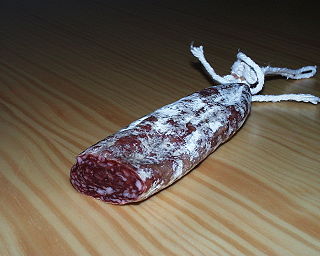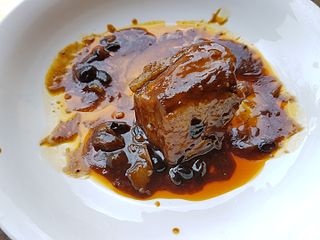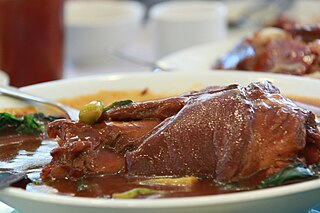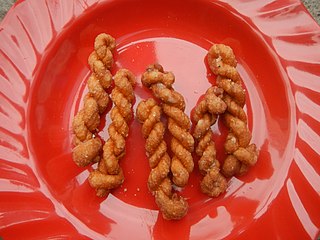
Meatloaf is a dish of ground meat that has been combined with other ingredients and formed into the shape of a loaf, then baked or smoked. The final shape is either hand-formed on a baking tray, or pan-formed by cooking it in a loaf pan. It is usually made with ground beef, although ground lamb, pork, veal, venison, poultry, and seafood are also used, sometimes in combination. Vegetarian adaptations of meatloaf may use imitation meat or pulses.

Filipino cuisine is composed of the cuisines of more than a hundred distinct ethnolinguistic groups found throughout the Philippine archipelago. A majority of mainstream Filipino dishes that compose Filipino cuisine are from the food traditions of various ethnolinguistic groups and tribes of the archipelago, including the Ilocano, Pangasinan, Kapampangan, Tagalog, Bicolano, Visayan, Chavacano, and Maranao ethnolinguistic groups. The dishes associated with these groups evolved over the centuries from a largely indigenous base shared with maritime Southeast Asia with varied influences from Chinese, Spanish, and American cuisines, in line with the major waves of influence that had enriched the cultures of the archipelago, and adapted using indigenous ingredients to meet local preferences.

Tinola is a Filipino soup usually served as a main course with white rice. Traditionally, this dish is cooked with chicken or fish, wedges of papaya and/or chayote, and leaves of the siling labuyo chili pepper in broth flavored with ginger, onions and fish sauce.

Pancit, also spelled pansít, is a general term referring to various traditional noodle dishes in Filipino cuisine. There are numerous types of pancit, often named based on the noodles used, method of cooking, place of origin or the ingredients. Most pancit dishes are characteristically served with calamansi, which adds a citrusy flavor profile.
Embutido, enchido or embotit (Catalan) is a generic term for cured ground meat products. The dictionary of the Royal Spanish Academy defines it as "intestine stuffed with minced meat, mainly pork; intestine stuffed with diverse ingredients". The term often applies to any of the many varieties of cured, dry sausages found in the cuisines of Iberia and the former Spanish and Portuguese colonies.

Longaniza is a Spanish sausage (embutido) similar to a chorizo and also closely associated with the Portuguese linguiça. Its defining characteristics are interpreted differently from region to region. It is popular in the cuisines of several regions of Spain, Argentina, Uruguay, Puerto Rico, Dominican Republic, El Salvador, Guatemala, Mexico and Chile. In the Philippines, it is called longganisa and has hundreds of variants with different vernacular tastes and forms due to the 144 ethno-linguistic groups of the archipelago. Longaniza essentially tracks the spread of Latin culture around the world. Longaniza derives from Lucanica, a sausage from Lucania in Southern Italy that was adopted by the Latins of Ancient Rome through military contact. From there it spread to Spain, and from Spain, centuries later, to every place in the world with modern "Latin" culture.

Menudo, also known as ginamay or ginagmay, is a traditional stew from the Philippines made with pork and sliced liver in tomato sauce with carrots and potatoes. Unlike the Mexican dish of the same name, it does not use tripe, hominy, or red chili sauce.

Bagnet, also locally known as "chicharon" or tsitsaron in Ilocano, is a Filipino dish consisting of pork belly (liempo) boiled and deep fried until it is crispy. It is seasoned with garlic, black peppercorns, bay leaves, and salt. First, the meat is boiled, and, then allowed to thoroughly drain excess moisture overnight before frying, to achieve its characteristic chicharon-like texture. Bagnet can be eaten on its own or with white rice. It can also be used as an ingredient or paired with other dishes like pinakbet and dinardaraan.

Pichi-pichi, also spelled pitsi-pitsi, is a Filipino dessert made from steamed cassava flour balls mixed with sugar and lye. It is also commonly flavored with pandan leaves. It is served rolled in freshly grated coconut, cheese, or latik before serving.

Humbà, also spelled hombà, is a Filipino braised pork dish from the Visayas, Philippines. It traditionally uses fatty cuts of pork belly slow-cooked until very tender in soy sauce, vinegar, black peppercorns, garlic, bay leaves, and fermented black beans (tausi) sweetened with muscovado sugar. It also commonly includes hard-boiled eggs and banana blossoms.

Embutido, or embotido, is a Philippine meatloaf made with ground pork and stuffed with hard-boiled eggs and sliced ham or various sausages. It is traditionally wrapped in aluminum foil and steamed, though it can also be baked.

Morcón or morconito, is a Philippine braised beef roulade made with beef flank steak stuffed with hard-boiled eggs, carrots, pickled cucumber, cheese, and various sausages. It is commonly served during Christmas and other festive occasions.

Ginataang kalabasa, also known as kalabasa sa gata, is a Filipino vegetable stew made from calabaza in coconut milk and spices. It commonly includes shrimp and yardlong beans and either bagoong or patis. It can also be cooked with fish, crab, or meat and a variety of other ingredients. It is a creamy umami-laden dish that is naturally slightly sweet due to the calabaza. It is a type of ginataan.

Pata tim, also spelled patatim, is a Filipino braised pork hock dish slow-cooked until very tender in soy sauce, black peppercorns, garlic, bay leaves, and star anise sweetened with muscovado sugar. It also commonly includes péchay and mushrooms. The dish is commonly served in regions in the Philippines with large Chinese Filipino populations, especially in the Binondo district of Manila.

Lucban longganisa is a Filipino pork sausage originating from Lucban, Quezon. It is a type of de recadolongganisa. It is characterized by its use of oregano and its garlicky and sour taste. It is made with coarse and lean pork, pork fat, coarse salt, onions, garlic, oregano, paprika, peppercorns, sugar, and vinegar. It can be prepared with or without the sausage casing.

Pilipit is a traditional Filipino deep-fried twisted doughnut. It is made with flour, eggs, milk, salt, and baking powder. It is made mostly identically to the shakoy doughnut, except for its crunchy and hard texture and its smaller and thinner size. The word pilipit means "twisted" in Tagalog.

Philippine asado refers to two different Filipino braised meat dishes. The name originates from Spanish asado ("grilled"), a reference to the original dish it was applied to, the Chinese-Filipino version of char siu barbecues usually known as pork asado. However, the Filipino versions have evolved to be braised, not grilled. The other Filipino dishes also known as asado are asado de carajay and asado matua. Unlike the Chinese-derived version, they are savory rather than sweet.

Everlasting, also known as the Marikina meatloaf, is a Filipino steamed meatloaf originating from Marikina. It is made with ground pork, Chorizo de Bilbao sausages, carrots, bell peppers, raisins, pickle relish, tomatoes, onions, and eggs. It is similar to the hardinera meatloaf of Quezon and is also traditionally steamed in an oval-shaped tin mold known as a llanera.

Maki mi, also known as pork maki or maki soup, is a Filipino thick pork tenderloin soup originating from the Chinese-Filipino community of Binondo, Manila. It is made from lean pork tenderized by a meat mallet. It is marinated in soy sauce, garlic, black pepper, rice wine or vinegar, and onions before being covered with egg whites or starch. It is then cooked in boiling beef stock, with beaten eggs dropped and stirred until they form strands. Egg noodles (mami) are also commonly added. The name "maki mi" takes its name from Hokkien Chinese, meaning meat soup noodles.

Batchoy Tagalog, also known simply as batsoy, is a traditional Filipino food originating in the northern Philippines. This soup is made with pork, pork offal, pork blood, noodles, chili leaves or garlic chives, green chilies, garlic, onions, and ginger. It is also referred to as sutsa or syutsa in the province of Quezon and sinuam in Angono, Rizal. This dish is usually paired with or eaten with cooked rice as a viand.




















